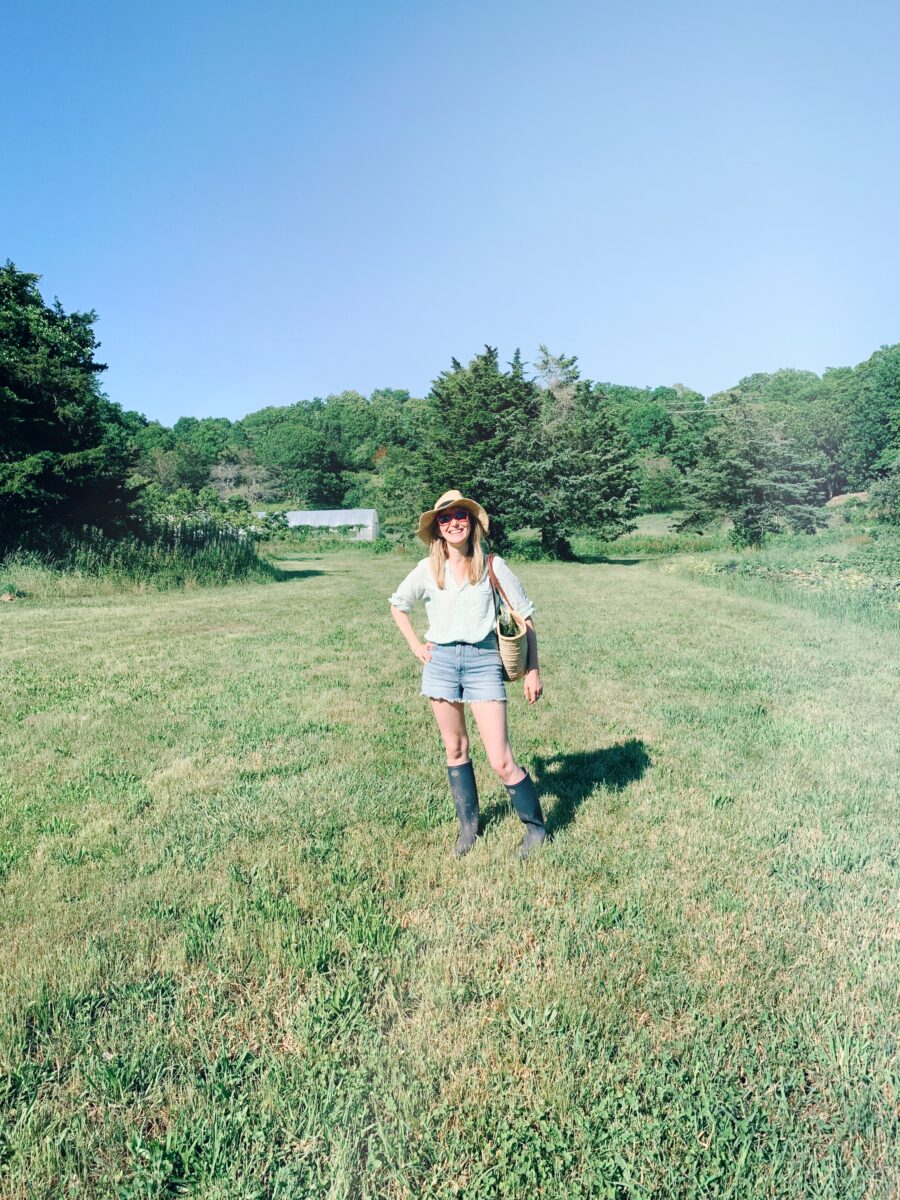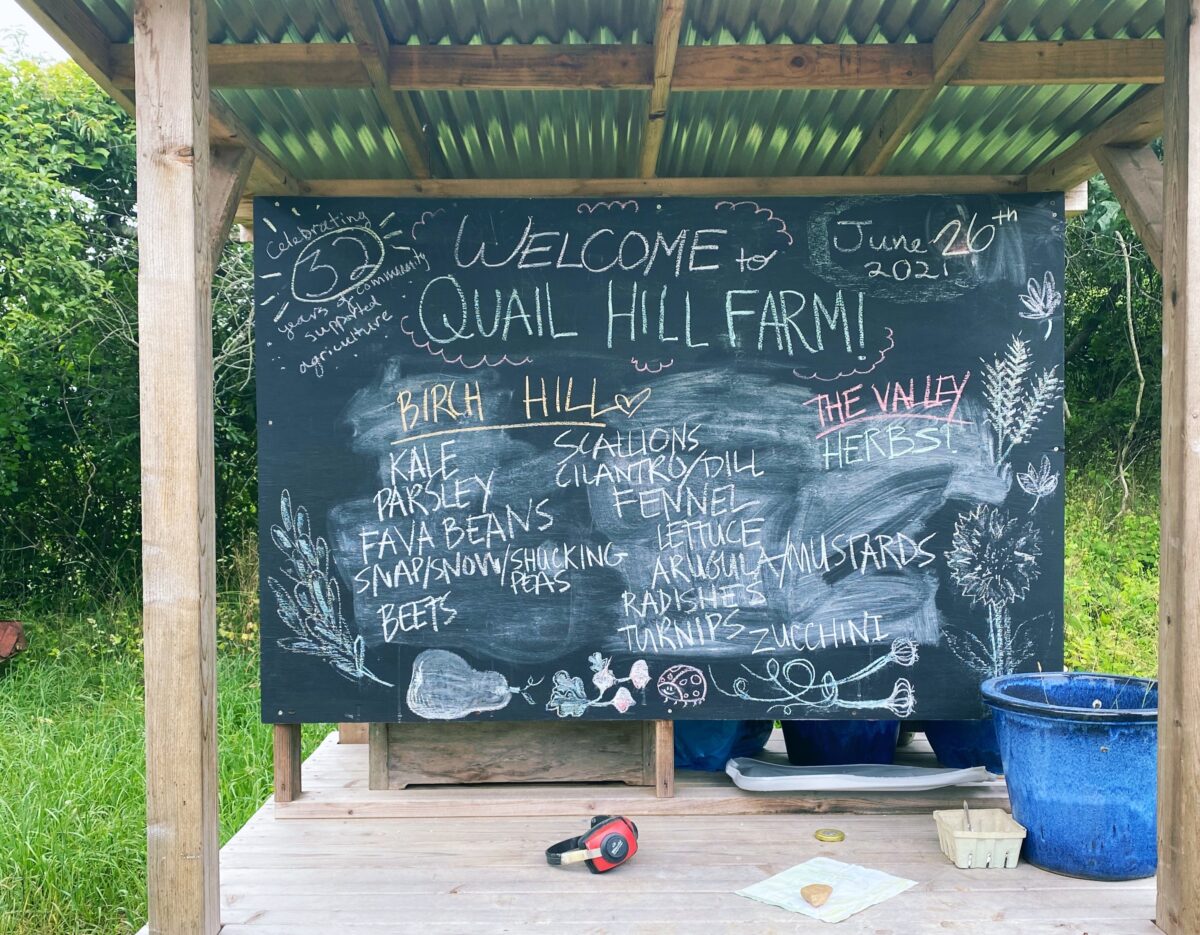The secret to finding more joy in less time

This summer, we’ve added something new to our routine. Every week, twice a week, we go to the farm. “The farm” in this case is Quail Hill, one of the original CSAs (community supported agriculture) in the US. You probably have one of these in your own community — you pay a subscription for the growing season, and in return you get a box containing a weekly sample of fresh produce. What’s unique about this one, though, is that we get to harvest the produce ourselves.
Tuesday afternoons and Saturday mornings, we grab a basket, put on tall boots, and drive the winding backroads to Quail Hill. We start by heading down to the Valley to check the blackboard, which lists what’s ready for picking that day. Then we cross the road and head up the hill to harvest our share. Albert wears Graham in the carrier while I scan for ruffly lettuce heads and the shoulders of radishes peeking up from the soil. Graham, in the carrier, munches fennel fronds and sneaks bites of snow peas. And if anyone spots a tractor, all bets are off — we stop what we’re doing and chase it down, Graham shouting “T-t-t-t-t” with delight.

There are 168 hours in a week, and these are only two of them, yet they’ve taken on outsized importance in the rhythm of our lives. When I wake up on a farm day, there’s a special buzz in the air. We anticipate our visits with enthusiasm. We speculate on whether the zucchinis will be big enough for picking. We wonder if there will be arugula, and if we should make a pizza to go with it. When we arrive, the cool breezes and sweet scents of wildflowers and grasses dissolve our stress. We become absorbed in the moment. There is a treasure hunt quality to harvesting, the surprise of finding a purple radish among the red ones, or fat peapod tucked under a curl of leaves. After, our basket full, there is the washing and sorting, the recipe-hunting and preparing, and of course the eating. Oh, the eating!
That these moments loom so large surprises me, and yet it makes perfect sense when we consider a fundamental truth about joy: not all moments are created equal.
Time clicks away in steady increments of seconds, minutes, hours, but the way we remember it is much more variable. Some moments — a phone call with a friend, a few bites of a perfectly ripe peach, a minute spent stargazing on the way to take out the trash — feel more significant than hours passed in front of a computer. Some moments just matter more than others.
Unlike clocks, our brains don’t just count the moments as they pass. They try to make sense of them. And in so doing, they assign a greater importance (and a greater share of our finite memory) to moments that feel more significant. When we look back on a day or a week or a season, we don’t see an encyclopedic catalog of everything that happened to us. We see a kind of highlights reel of what our unconscious mind determined was most important to commit to memory. It’s this highlights reel — not the average of everything we experienced in the week — that determines whether we feel we had a good week, or a bad one.
I find this interesting because there’s an approach to mental well-being which suggests that we should be more mindful and present in every moment. As a goal, this feels inspiring. Time is our most limited resource, so why let any of it go to waste? But in practice, I’ve often felt like this mentality sets us up for failure. Is it really possible to be mindful of every minute? Through the lens of “make every moment count,” a mindless hour scrolling TikTok or Twitter isn’t just a frivolous diversion; it’s something to feel guilty about. And so instead of feeling mindful and present, we often end up feeling guilty and lazy, as if we are simply not trying hard enough. As Ruth Whippman wrote in a 2016 guest essay for the New York Times entitled, “Actually, Let’s Not Be in the Moment,” “The implication is that by neglecting to live in the moment we are ungrateful and unspontaneous, we are wasting our lives, and therefore if we are unhappy, we really have only ourselves to blame.”
But what if instead of forcing ourselves to live in all the moments, we accepted that some moments matter more than others, and prioritized the ones that really do?
We might…
…spend one focused, joyful hour each evening playing with our kids rather than several harried, guilty, distracted ones.
…plan two fun, meaningful activities into the calendar each week, rather than trying abstractly to make the most of every moment.
…make family dinner a must on Sundays and Wednesdays, and turn it into a time everyone looks forward to, while letting the other nights be more laid-back, instead of pushing for everyone to be at the table every night of the week.
…make time to get outside every day, knowing that at the end of the week, we’ll remember those moments more than the eight hours of our workday.
…allocate money in the budget for a garden, knowing that a few minutes a day weeding and arranging flowers would bring more joy than one extra dinner out a month.
What I’ve noticed about this approach in my own life is that it helps to alleviate perfectionism. Rather than trying to make every moment special, I can accept that there are going to be gloomy days and arguments and a certain amount of monotony. Yes, maybe some mornings I’ll sing while I empty the dishwasher but most days it’s just a task that I will get through on the way to other things I need to do. And that’s ok. Because every day, there will also be flickers of magic. My job is to find these flickers, and savor them.
What’s more, I can start to rearrange my life to create more opportunities for joyful moments, and more space to experience them. For example, those two hours a week at the CSA. If we hadn’t planned for these and joined in advance, Tuesday and Saturday would just be ordinary days. But now they’re part of our routine. I know they’re coming, and I keep my schedule clear for them. Joy isn’t just left up to chance.
So what determines which moments matter, and how much say do we have in the process? Understanding certain cognitive biases can help illuminate the ways the brain sorts our moments and assigns value to them. Here are a few tips for making the most of your moments:
- Aim for intensity. The peak-end rule tells us that we’re mostly likely to remember the emotional peaks of an experience — the most intense moments, whether positive or negative — and the way the experience ends.
- Do something new. The novelty bias tells us that new experiences are more likely to capture our attention than repeated ones, because new experiences are full of unfamiliar sensations that draw our focus.
- Make time for play. Play is particularly good at bringing us into the moment. When we’re absorbed in a game, puzzle, or make-believe adventure, our consciousness of time recedes, and we’re fully present.
- Invite others along. Studies show that we tend to enjoy the same activities more when we do them with others than when we do them alone. If that’s not possible, sharing a photo or story of the experience with someone can also heighten our joy.
- Consider your values. Our values filter our experience of the world. If you value creativity, an hour spent on a craft project will be more meaningful to you than a day at a ballgame. If you value nature, a daily walk would be more precious than an hour spent cooking new recipes.
Ironically, we almost didn’t join the CSA. When we had looked at joining in previous summers, it seemed expensive. But with Graham now a year old, we needed to find things that we could do together outdoors, and we decided to give it a try. Now that we’ve fallen in love with the place, the calculation looks much different. It’s no longer an exchange of money for vegetables. It’s a venue for time spent together as a family. It’s a sense of belonging in and support for a community of people who are devoted to organic, sustainable cultivation of the land we live on. It’s a chance to be closer to that land, and it’s an opportunity for Graham to grow up knowing where food comes from, and what it looks like before it’s shined up and stacked in rows on grocery shelves. It’s moments that really matter.




Discussion (5 Comments)
Your message hit home and I treasure the time I spend in the back yard in Texas playing in the dirt, noticing the critters, examining the vegetables. Brings back memories of Colorado orchard and summers where I grew up, and time pretty much ceases to exist on the clock. Playtime and creativity also are paramount in my being happy – no matter the age, now 64 and happily retired, as well EXERCISE to keep strong and fit, for a hopeful long life. (For another topic – connecting joy with movement and dance of the BODY and soul. LOVE your book and the blog . Thanks
Every twenty-four hours, rain or shine, sometimes during the day and sometimes at night, I go outside and look at the sky. I see clear blue, clouds, rain, fog, star spangled nights, full moons, thunderheads and more. I am quiet enough for a few seconds to be able to move into the presence of my Higher Power. I say, “Thank you.” Just that.
Once in every twenty-four hour period, day or night, I stop and go outside, walk a little ways off from the house or business office, and look up at the sky. I’ve seen days skies of clear blue, blue with white
Every twenty-four period, day or night, rain or shine I go outside and look up at the sky. I see piercingly blue skies, cottony clouds, fog, wind-tossed clouds, thunderheads, sun showers, full moons, star spangled skies, eclipses and meteor showers. After a few seconds to get still, I draw into the presence of my Higher Power and pause for one moment — just long enough to say, “Thank you.” Just that.
Thank you for this
It’s really insightful and practical in a way I’ve not read before
I’m doing the 2 family dinners a week and 2 activities a week thing right away and have sent the link to my sisters and mum
Thank you
Working in a garden, one’s own garden, however small is a joy! All my life I have been a scientist, and now after retirement, also a poet. My most creative phase, and a very satisfying one at that, was when in my final school year I had the occasion to nurture a small garden, about 12 feet x 15 feet, a part of our residence just across the living room. It was in 1961, and for watering my plot of garden I had a hand operated water pump. And I did it by making long strips of the soil, separated by small mounds of soil, with breaks in them to direct the flow of water.
Growing onions was fun. From seeds indoors, first growing them into tiny plants, and then transplanting them into the garden. After a few weeks of tendering them I could see big onion bulbs growing fast. Growing garlic was the easiest. Onions, garlic and potatoes all grew underground. Then I tried my hand at vegetables like ladyfingers, radish, and gourd all growing into large plants, from tiny seeds. Mint leaves and coriander leaves grew on surface of the soil, quick and fast.
The fun part was when I came home during recess of my school for a quick lunch, during which I would pull out a radish, fresh from my garden, wash it and eat it – so tender, and tasty. The whole exercise of maintaining my private garden was a good relaxation in between my final-year school studies.
A big challenge that I undertook those days was to grow a mulberry tree. To start with I got a tiny plant for this from a gardener. It was just about 3 inches high, and had 3-4 leaves, and the season then was summer. Any amount of sprinkling water on the leaves of this plant was not enough to help this plant start its journey to grow. Then, I did an ingenious experiment. I put a small 8 inch x 8 inch temporary shade made from a think sheet of cardboard supported by four bamboo broom sticks about a foot high, stuck in the ground around this plant. It worked because the shade protected the plant from the hot sun trying to wither it. With regular watering, it started growing into a plant and a small bush-size tree, when it was time for me to go away to live at my university. I came back on vacation after a few months to see this mulberry plant having grown taller than me. It now did not need any watering manually, since it could draw its own through its roots, spreading around. Come next vacation and it was bearing mulberry fruits. After another two years I shifted to a distant town for my further studies and a job. I returned after a year or two to see a huge mulberry tree, oversized for my small garden, with requests from a neighbor to remove this tree as its roots were now pilfering into the foundation of his compound wall. Alas!, my mulberry tree, MY JOY, had to be cut and its roots dug up lest it shows up above the ground again.
—— Prof. Dr. J.V. Yakhmi